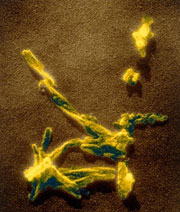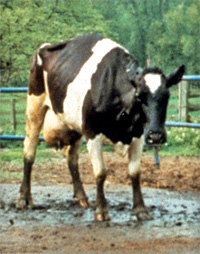Proteins That Kill: Will Prions Be the 21st Century AIDS?
by www.SixWise.com
Prions are mutated, slightly misshapen proteins. These agents
are thought to be responsible for a number of closely related,
currently incurable, rapid-spreading and fatal "prion
diseases" known as transmissible spongiform encephalopathies
(TSE).
Of these, the most talked about these days is bovine spongiform
encephalopathy (BSE), or mad cow disease, which infects cows.
It is now known that this disease can be transferred to humans
who eat meat or other tissue from BSE-infected cows. In humans,
the disease is called Creutzfeldt Jakob disease (CJD), or
new varient Creutzfeldt Jakob disease (nvCJD), when referring
to the type related to BSE. In sheep, the disease is called
"scrapie."
|

Mutated prions are thought to cause a fatal brain disease
in humans called Creutzfeldt Jakob disease (CJD).
|
Why "nvCJD" is Of Great Concern
There is no cure for any of the TSE diseases, including the
human forms, CJD and nvCJD. This infectious brain disease
kills quickly once symptoms start, but seems to come out of
nowhere because it can lie dormant for up to 40 years, according
to the National Institute of Neurological Disorders and Stroke
(NINDS).
The disease causes small holes to develop in the brain (making
it look like a sponge), which causes changes in personality,
loss of body function and finally death.
Prions Can't be Killed
Because prions are not actually alive, and contain no genetic
information, they cannot be killed by any of the typical methods
of heating, sterilizing, etc.
Normal prions occur naturally in the body and are harmless.
But when a prion takes on a different folded shape than its
normal counterparts, it becomes infectious. It's thought that
once a prion becomes infectious, it alters other prions in
a chain reaction.
The abnormal prions then clump together, which researchers
believe may lead to neuron loss and brain damage.
"The New AIDS"
Because prions are so difficult to kill, and because they've
been identified in the blood supply, some are calling prion
diseases "the new AIDS."
|

About 150 people have died from nvCJD, which they most
likely got from eating BSE-contaminated meat.
|
There are several forms of CJD, with the most common (85
percent) being sporadic CJD, which appears in older people
with no known risk factors. There's also hereditary CJD, which
accounts for about 5 percent to 10 percent of cases, and acquired
CJD, which is transmitted by exposure to infected brain or
nervous system tissue, typically through a medical procedure.
The new variant variety differs in that it typically affects
younger people and is thought to be caused by eating BSE-tainted
meat. There have been about 150 confirmed deaths from nvCJD
so far. It's thought that BSE was originally transmitted to
cows because they were fed sheep meat infected with scrapie
along with other cow parts that may have been infected.
No one knows for sure how many people have had, or have,
a form of TSE, because it's now becoming clear that some cases
of dementia and Alzheimer's disease may actually have been
TSE. But because diagnosis would entail an autopsy, which
most people don't have done on elderly relatives, the cases
slip by undetected.
What Can be Done?
There is no test to detect prion-related diseases, no one
knows for sure how long they can lie dormant before springing
up, there is no treatment and there is no cure. Aside from
humans, sheep and cattle, prion-related diseases have also
been found in cats, mink, mule, elk and deer.
At this stage, the only real way to prevent prion diseases
would be to take great care to stop including contaminated
tissues, meat and more in animal feed, and stop feeding cow
parts to other cows. Further, every cow should ideally be
tested for the disease -- a test that reportedly costs about
$30 a cow, making the ideal unlikely -- before it's allowed
to be sold.
When, and if, that will ever happen is completely unknown.
In the meantime, one way to ensure that your meat is prion-free
would be to find a supplier of grass-fed beef. A grass-fed
cow would not be exposed to prions via contaminated feed (if
they are truly all grass-fed).
The U.S. Food and Drug Administration does maintain that
the U.S. beef supply is safe to eat, however. "Consumers
should feel very confident that the system of multiple firewalls
maintained by Federal agencies protects them from possible
exposure to BSE. In addition, we believe it is important for
consumers to also understand that scientific research indicates
that muscle meat is not a source of infectious prions,"
says the FDA.
Recommended Reading
How
Many Insect Parts and Rodent Hairs are Allowed in Your Food?
The
Six Most Feared but Least Likely Causes of Death
Sources
National
Institute of Neurological Disorders and Stroke
Prion-Related
Diseases
Madcow
Opens Door to Grass-Fed Beef
U.S.
Food and Drug Administration